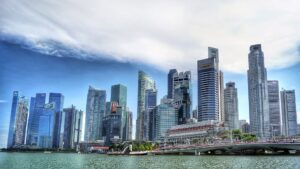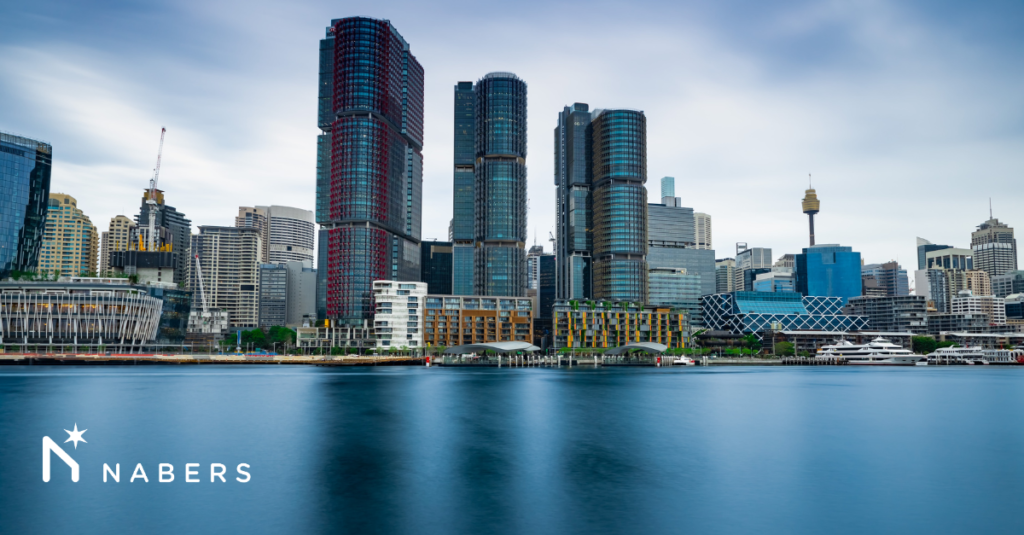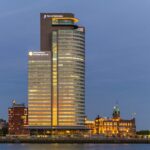

Navigating global climate action with Carlos Flores, Director of NABERS
Carlos Flores, the Director of Australia’s NABERS, stands out as a visionary leader shaping a greener future in Australia and beyond. Leading the largest building sustainability initiative in Australia, he discusses pivotal changes in the real estate industry, highlighting the evolution of climate action beyond traditional spaces. The interview also explores the transformative impact of the Green Buildings Tool, offering insights into its potential to break down barriers and revolutionise sustainability practices globally. Carlos Flores envisions a future where NABERS’ success extends to Europe, contributing to the broader mission of global decarbonisation and collaborative sustainability efforts.
For people who don’t know you yet: what is your role and what ignited your personal mission for sustainability?
“I am the Director of the National Australian Built Environment Rating System (NABERS, pronounced ‘neighbours’). NABERS is a government program, and the largest building sustainability and decarbonisation initiative in Australia. I have the fortune to lead a team of about 65 colleagues, who are spending their careers in the service of trying to save the planet.

My sustainability journey is closely linked to my upbringing in Chile. I have vivid memories as a little kid of the 1992 Earth Sumit, which was was happening in nearby Brazil. Chile had just emerged from a two-decades under General Pinochet, and our school textbooks still reflected his dictatorship’s general lack of regard for the environment. The Earth Sumit triggered a major change, which allowed generations of Chilean children like me to learn at school that humans are having a negative impact on nature and that we can do something about it.
A decade later, I was fortunate to take an inspirational energy policy course with a major contributor to the Intergovernmental Panel on Climate Change (IPCC), in my last semester at engineering school. That professor gave me my first job in energy and climate policy a few months later, where I got to see him finalise his contributions for what became the IPCC’s Fouth Assessment Report in 2007. It was an experience that inspires me to this day.”
Looking back for a minute, what has the past few years given the real estate industry in relation to sustainability?
“The past few years have been a game-changer in building sustainability, in Australia as well as globally. Historically, commercial buildings in Australia have been fortunate to have initiatives like NABERS and Green Star, which have brought industry and government together regarding sustainability policy for over twenty years. The results of these joint efforts have been truly remarkable: sectors like offices and shopping centres in Australia have reduced their energy use by over 40% since 2010. These are among the fastest rates of energy savings across entire building sectors in the world.
This has been happening in Australia for some time, but the last few years have brought a really important change: we are starting to see ambitious climate action extend outside the traditional commercial building space. We are now working with public hospitals and school portfolios, who are setting ambitious energy efficiency and decarbonisation targets across portfolios with hundreds or even thousands of buildings. We are also seeing leaders in sectors like hotels publicly disclose and set targets to improve their NABERS Energy ratings, which is a momentous step in a sector where the ‘green talk’ has historically ourpaced the green walk.
The last few years have also brought a growing consensus on what is needed for the building sectors to reach net zero emissions by 2050, including the major roles of building electrification and reducing embodied carbon. Five years ago, few Australian property portfolios had concrete targets on these two areas, which are now becoming front and centre on their updated plans to fully decargonise their operations.
Another breakthrough of the past few years has been the rise of sustainable finance. We saw the rise of global ESG indices like GRESB and CDP in the last decade, followed by the EU Sustainable Finance Taxonomy and the upcoming Australian Sustainable Finance Taxonomy. All of this, coupled with ever-growing climate literacy and agency among investors and banks are starting to turn more and more building portfolios that had been laggers in this space into active sustainability champions.”
What is the impact of the Green Buildings Tool and why are you supporting the tool in Australia?
“Historically, the sustainability profession has assumed access to finance to be the largest barrier to climate action in buildings. But we now have decades of research showing that many building owners around the world repeadetly fail to invest on cost-effective energy efficiency, despite having readily access to finance. This is because are arguibly other larger barriers to climate action than just money.
With 25 years of experience with NABERS in Australia has unveiled one of those large barriers: the fact that most building owners simply do not know how well (or poorly!) their building is performing in terms of energy and emissions. We see that poorly run buildings can use four or five times more energy per year than their most efficient competitors in the same market. Such a huge wastage of energy and money should make energy efficiency an easy sell to those owners, but it doesn’t, because most of those owners simply do not know how ineficient their buildings are.
In Australia, NABERS ratings have provided thousands of owners of large buildings with their first-ever indication of how efficient their building is compared to their competitors, based on real energy use. Owners who receive a poor NABERS star rating are genuinely surprised they are wasting so much energy compared to everybody else, and we see a high percentage of them investing on energy efficiency short after.
CFP’s Green Buildings Tool is helping amplify this positive impact, by reaching buildings which have historically been outside the reach of NABERS and give them a first estimate of what their NABERS performance might be, and help understand what steps they can take to improve that, reducing bills and carbon emissions. It is a really exciting development for us.”
Many are talking about a looming recession, at the same time ESG is becoming more and more common. How do you think 2024 will unfold?
“The world has faced a range of economic challenges in the past four years. But one thing we have learned from the global response to these challenges is that climate action has become a very powerful tool to combat tough economic times.
Energy efficiency reduces cost of living for people and makes businesses more cost-competitive. Solar PV and wind power are cheaper than electricity from fossil fuels, making energy cheaper for everyone. And, as the International Energy Agency showed repeatedly during COVID, energy efficiency and renewables are great job creators. These bring exactly the kind of positive impacts economists seek when facing economic headwinds.”
“Recession or not, we all know time is ticking to save the planet from dangerous climate change. We are facing the greatest challenge in human history, and we don’t have time to take a gap year. So whatever the economy brings in 2024, we must continue to make great progress towards decarbonising the world.”
– Carlos Flores, Director of NABERS
Considering the global focus on sustainability, what trends or best practices from international counterparts do you find inspiring, and how is NABERS aligning itself with these global movements?
“Today, there are literally millions of people working to make the world economy more sustainable. Governments and organizations around the world are trying all kinds of solutions to shared environmental challenges, which means we can all learn from the successes (and failures!) of others.
I am fortunate that my work exposes me to many great initiatives globally. I have represented Australia at several building initiatives at the International Energy Agency, and have met numerous talented colleagues working in sustainability through NABERS’ presence in New Zealand and the United Kingdom, and our continuously emerging partnerships in Europe.
There are too many things I am inspired by to list them all, but I am inspired by the vast ecosystem Germany has created to enable the electrification of thousands of buildings every year. I am inspired by the unbelievably fast home retrofits solutions the Dutch have pioneered, and I am inspired by developing countries like my home country of Chile, which are taking meaningful action on climate change despite having fewer resources and more complex social needs.
We at NABERS in Australia are very fortunate to work with a community of thousands of industry-based sustainability champions. They are very well connected internationally, and constantly give us feedback on how to replicate the successes of global movements to create a positive impact in Australia. Two examples of major changes we are making based on industry feedback include:
- In 2021, we made changes to NABERS ratings to much more strongly recognize the benefits of building electrification. We now expect NABERS ratings themselves and any policies that use them to become major drivers for building electrification in Australia.
- Later on in 2024, NABERS will launch the national standard for measuring and reducing embodied carbon in new buildings in Australia.”
And how do you envision expanding NABERS in Europe through the roll-out of the Green Buildings Tool and related best practices and regulation?
“NABERS is a government initiative to make buildings more sustainable. The goal of our international partnerships is not to make a commercial profit or to ‘win’ over other rating tools. Instead, our goal is to positively contribute to global decarbonization efforts, by sharing Australia’s most successful building sustainability initiative (NABERS) with others.
Environmental challenges like climate change and the waste crisis are global in nature. To succeed, we need to make efforts to learn from successes elsewhere, and to be willing to share what is working for us. The international partnerships we have established with New Zealand and the UK, and which we are exploring with other European countries, are our way to achieve that.
We are really excited about our partnership on the Green Buildings Tool. We think it has the potential to help support a roll-out of the performance-based approach that NABERS has pioneered in Australia, New Zealand and the UK (which is based on real energy and emissions, rather than theoretical models and assumptions), to assist the decarbonisation efforts of buildings in other countries.”
CFP Green Buildings works together with NABERS and other partners in Australia. Together, we launched the Green Buildings Tool in Australia in 2023. Would you like to learn more? Read all about it in this article or get in touch with us.






